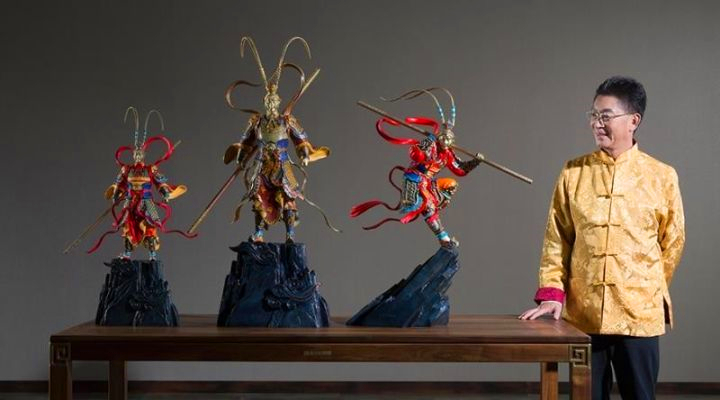Fashion studies in aesthetic context

Yu Guang, founder of the Tongshifu company, innovated upon traditional copper crafts and developed works themed on the Journey to the West. The picture above shows the statue of the Monkey King and famous actor Zhang Jinlai who played the Monkey King in a TV series.
Recently, an international symposium titled “Contemporary Aesthetics and Anthropology: Fashion Studies” was held in Hangzhou. More than 100 experts and scholars from China and around the world attended the meeting. They carried out in-depth discussions on aesthetic and fashion issues from multiple perspectives, such as “fashion and historical memory,” “fashion and crafts” and “fashion and cultural heritage.” Scholars said that fashion culture has changed people’s attitudes toward life, emotional structure and aesthetic pursuits. There is much to be learned by studying the characteristics of contemporary fashion culture from an aesthetic point of view.
Theoretical support
With recent changes in Chinese society and contemporary culture, the size of the cultural economy in terms of China’s economic structure has significantly increased. Fashion research has become an aspect of art and aesthetic circles. Wang Jie, a professor from the College of Media and International Culture at Zhejiang University, said that in the process of modernization, the nature of aesthetic studies in China has changed. The “double helix” emotional structure of Chinese aesthetic modernity has transformed into a very complicated dialectical state within the contexts of aesthetic modernity of Chinese society, avant-garde art and aesthetic taste in fashion.
In terms of research on the emotional elements of fashion in China, Wang advocated the use of methods of aesthetic anthropology. He indicated that empirical research on philosophical and art anthropology should be integrated. Film art should emphasize aesthetic significance and emotional structure, and pay attention to the “sense of the scene,” he added.
Traditions now fashions
“Tea drinking, flower appreciation, playing the Chinese zither, poem composition and collecting antiques are all gaining popularity: the revival of traditional Chinese culture has become a new fashion trend in modern Chinese society,” said Fang Lili, director of the China Society for Anthropology of Art. Fang pointed out that China’s traditional handicraft industry has been revived. While it is changing the people’s way of life, the industry also changed the nation’s economic and cultural structure, and promoted industrial restructuring, thus turning “made in China” into “created by China.”
In the future high-tech society, the most fashionable products should also have a cultural and artistic content. Fang argued that this kind of revival of outstanding traditional culture is an important means of stimulating the vitality of traditional Chinese culture. On the basis of the development of industry 4.0, new energy and the Internet, China will once again create world-class fashion products with contemporary Chinese aesthetic views and contemporary Chinese design culture. These products will enter the international market through the Belt and Road.
Fashion embraces traditions in the form of innovation. Yu Jianwen, a special term professor from the Tianjin Academy of Fine Arts, said that fashion is boundless, diverse and superimposed. It is both national and open in terms of emotional structure. In aesthetic consciousness, fashion is inseparable from art. Art leads to new fashion tastes and styles. It is the reflection of imagination, association and creativity. The essence of fashion is to present beauty and love in an innovative way.
Aesthetic trend
Fashion reveals the aesthetic styles of modern cities. Yang Xiangrong, a professor from the School of Arts at Zhejiang Institute of Communication and Media, said that fashion shows the essential characteristics of aesthetic modernity, which is to say, the “transient nature” or “sense of the current moment” of modern life. This “transient” aspect of fashion is also what grants it infinite possibilities for innovation. However, this kind of innovation, to a considerable extent, is achieved through the use of tradition, and the novelty shows in new forms through the reimagination of traditions.
Luo Ruchun, a professor from the School of Literature and Journalism at Xiangtan University, said fashion is a typical phenomenon of modernity and even postmodernity. Although traditional society had no lack of fashion, it was only in modern times that fashion gained its current depth and level of popularity.
As a combination of art and science, fashion has continued to weaved into new areas. Ales Erjavec, a professor from the Slovenian Academy of Sciences and Arts, said its elements should be used to construct anthropology, aesthetics and science, and improve research methodology. The significance of fashion research is to open up horizons, practice, and understand the frontiers of the industry. He added that fashion research is a multi-disciplinary study. It is a comprehensive interpretation of the community and human psychology. In human evolution, fashion research is a science stretching beyond various disciplines. It is the crystallization of human wisdom.
